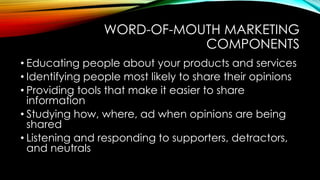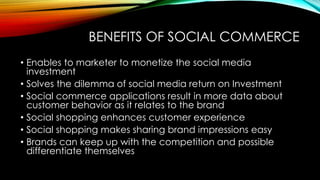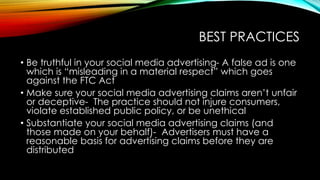Social commerce
- 1. SOCIAL COMMERCE MKT 495 By: Toni Gabelsberger
- 2. ONLINE SHOPPING •E-commerce- The practice of buying and selling products and services b using the internet •Social shopping- Situations where consumers interact with others during a shopping event •Purchase pals- Our shopping companions who help us to think through our alternatives and make a decision
- 3. SHOPPING PROCESS Problem Recognition Information Search Evaluation of Alternatives Purchase Post-Purchase
- 4. INFLUENCES ON PURCHASING • Review- Assessments with detailed comments about the object in question • Ratings- Scores generated by users that are based on quality, satisfaction, or popularity on a scale • Verification- Consumers use ratings and reviews when seeking out information online about the object I question and use these to make their decision
- 5. BENEFITS OF REVIEWS AND RATINGS TO SELLERS •Online reviews= increased sales and new customers •Consumers pay more for products with higher ratings •Ratings and reviews increase search traffic
- 6. SOCIAL COMMERCE STRATEGIES • User galleries- Virtual galleries where users can share creations, shopping, and wish lists. Also called user-curated shopping • User forums- Groups of people who meet online to communicate about products • Share tools • Testimonials
- 7. WORD-OF-MOUTH MARKETING COMPONENTS • Educating people about your products and services • Identifying people most likely to share their opinions • Providing tools that make it easier to share information • Studying how, where, ad when opinions are being shared • Listening and responding to supporters, detractors, and neutrals
- 8. OTHER PROMOTIONS • Provide shopping from within a user’s feed on their social community of choice (i.e. Facebook) • Sales promotions- Short-term deals designed to generate demand in a specific time- period • Social shopping portals- Enables conversion from browsing to buying (i.e. Wanelo)
- 9. PSYCHOLOGY OF INFLUENCE •The factors that make it more or less likely that people will change their attitudes or behavior based on a persuasive message
- 10. CONFORMITY • A change in beliefs or actions due to group pressure • Common culprits of conformity: • Cultural pressures • Fear of deviance • Commitment issues • Group unanimity, size, and expertise • Susceptibility to interpersonal influence
- 11. SCARCITY • We tend to want things more if we think we can’t have then • Marketing tools that use the technique of scarcity include: • Time-sensitive deals • Limited edition products
- 12. RECIPROCITY •We have an urge to repay debts and favors •Businesses/sellers use this through sampling (i.e. free trials)
- 13. BENEFITS OF SOCIAL COMMERCE • Enables to marketer to monetize the social media investment • Solves the dilemma of social media return on Investment • Social commerce applications result in more data about customer behavior as it relates to the brand • Social shopping enhances customer experience • Social shopping makes sharing brand impressions easy • Brands can keep up with the competition and possible differentiate themselves
- 14. THE LAW OF SOCIAL ADVERTISING MKT 495 By: Toni Gabelsberger
- 15. SOCIAL ADVERTISING • Social advertising is comprised of any online advertising conducted on social networks such as: • Facebook • YouTube • LinkedIn • Twitter • Social network advertising focuses on primary objectives: • Building awareness • Driving sales • Increasing the number of followers and fans
- 16. BEST PRACTICES • Be truthful in your social media advertising- A false ad is one which is “misleading in a material respect” which goes against the FTC Act • Make sure your social media advertising claims aren’t unfair or deceptive- The practice should not injure consumers, violate established public policy, or be unethical • Substantiate your social media advertising claims (and those made on your behalf)- Advertisers must have a reasonable basis for advertising claims before they are distributed
- 17. LANHAM ACT A piece of federal legislation that governs trademark law in the U.S. and which prohibits trademark infringement, trademark dilution, and false advertising
- 18. CAN-SPAM ACT • Controlling the Assault of Non-Solicited Pornography and Marketing Act of 2003 (CAN- SPAM Act) • This makes it “unlawful for any person to initiate the transmission, to a protected computer, of a commercial electronic mail message, that contains, or is accompanied by, header information that is materially false or materially misleading.”
- 19. COPPA • The Children’s Online Privacy Protection Act (COPPA) • Imposes certain requirements on operators of websites or online services directed to children under 13 years of age, and on operators of other websites or online services that have actual knowledge that they are collecting personal information online from a child under 13 • Parental notice and parental consent must be given
- 20. WORKS CITED • McHale, R., & Garulay, E. (2012). Navigating social media legal risks: Safeguarding your business. Indianapolis, Ind.: Que. • Tuten, T., & Solomon, M. (2013). Social media marketing. Boston: Pearson.



















